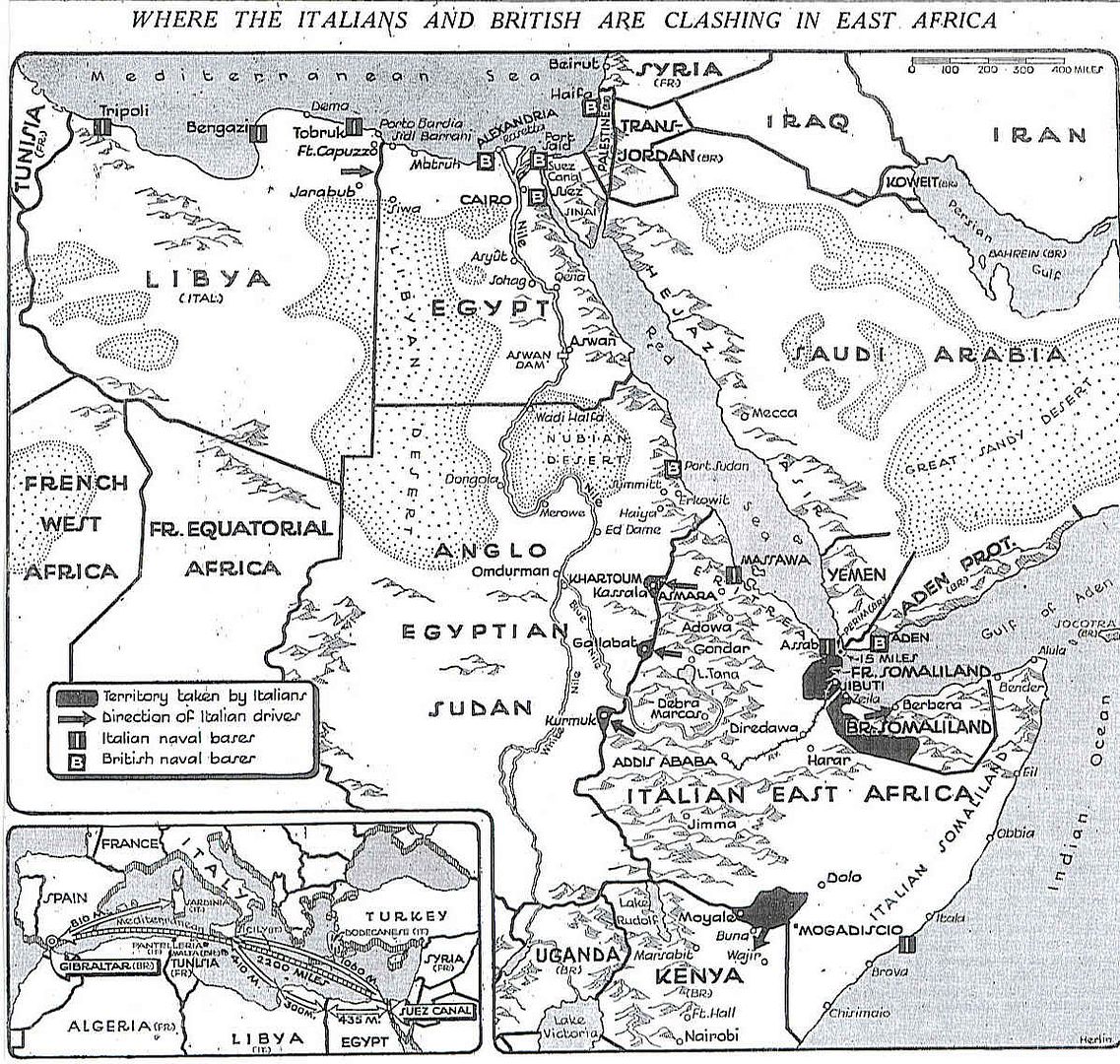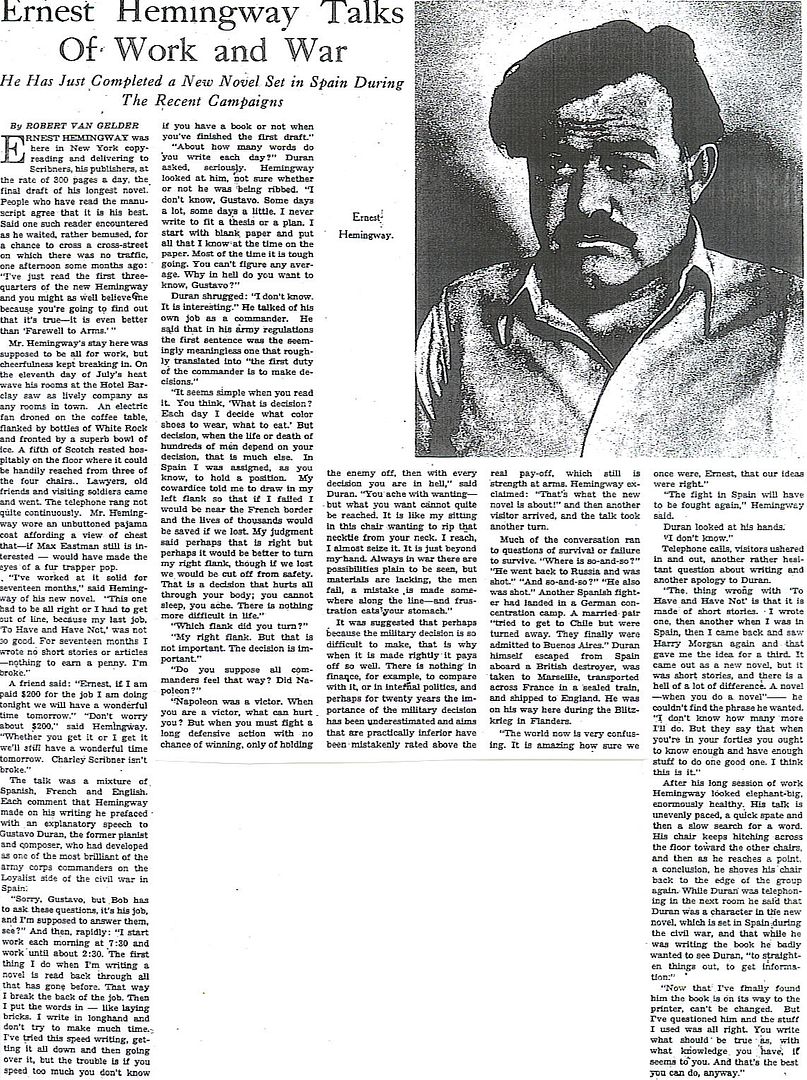
Posted on 08/11/2010 5:04:02 AM PDT by Homer_J_Simpson


























Michael Korda, With Wings Like Eagles: The Untold Story of the Battle of Britain
News of the Week in Review
Twenty News Questions – 14
Where the Italians and British are Clashing in East Africa (map) – 15
Successes in Air War Bolster British Hopes – 16
Nazis Urge Spartan Habits – 17
Changes in France Expected – 18
Suez Italy’s Goal in African Sector – 18-19
As Japan Sees the “New Order” in East Asia (map) – 20
Social Security Grown to Giant Size in 5 Years (by Luther A. Huston) – 21-22
California Law Favors Johnson (by Arthur Caylor) – 22
Answers to Twenty News Questions – 23
Ernest Hemingway Talks Of Work and War (from N.Y.T. Book Reviews, by Robert Van Gelder) – 24
Sketch of future development above the George Washington Bridge * - 25
* If anyone has seen this area along the Hudson since 1990, please inform the rest of us whether you can still observe autogiros flying in and out of the apartment complexes there.
Oops, again. Please see the contents on the previous reply.
http://www.onwar.com/chrono/1940/aug40/f11aug40.htm
Italians advance in British Somaliland
Sunday, August 11, 1940 www.onwar.com
In East Africa... In British Somaliland the Italians advance to and attack the main British positions on the Hargeisa-Berbera road at Tug Argan. General Godwin-Austen has arrived to command the British force.
Over Britain... There are German air raids on Weymouth and Portland. The RAF loses 32 planes and the Luftwaffe 38.
http://homepage.ntlworld.com/andrew.etherington/month/thismonth/11.htm
August 11th, 1940
UNITED KINGDOM: Battle of Britain:
RAF Fighter Command: Weather, fine.
38 Luftwaffe and 32 RAF planes are downed in air battles today.
Dover and Portland heavily attacked. Several senior Luftwaffe officers killed or captured.
Convoys off east coast attacked.
At 1519, the Llanfair, a straggler from Convoy SL-41, was hit by one torpedo from U-38 in the stern and sank after 11 minutes west of Ireland. Three crewmembers were lost. The US-flagged California picked up the master and 29 crewmembers. (Dave Shirlaw)
At night Merseyside and the Bristol Channel are mined.
Squadron log No. 74 squadron (Manston and Hornchurch: Spitfire I and II) commanded by South Africa’s “Sailor” Malan - Squadron log reads:-
take off at 0749 hrs., second patrol: take off 0950, third patrol: take off 1145, fourth patrol: take off 1356.
Ten Bf110’s and 13 Bf109s (including six of JG 2) are lost. Bombs fall for the first time on York and heavy raids are reported on Bristol and Plymouth.
During a heavy air raid on Weymouth and Portland, ASW Trawler HMS Hertfordshire was in Admiralty floating dock (AFD19) which was holed and strained. The Hertfordshire suffered some splinter damage. (Dave Shirlaw)
At night a Bristol searchlight team hold a He-111H in their beam long enough for a Hurricane of 10 Group to bring about the Groups first night success.
RAF Bomber Command: 2 Group: 2 Blenheims of 604 Squadron escorted by 3 Spitfires of 152 Squadron attempted to set fire to waterborne He59s off France.
4 Group (Whitley). Bombing - oil refineries at Gelsenkirchen and Frankfurt - ‘Razzling’.
10 Sqn. Eight aircraft to Gelsenkirchen. All bombed primary and ‘Razzled’. Four damaged by Flak, six damaged by burning ‘Razzles’.
51 Sqn. Eight aircraft. One returned early, six bombed primary and ‘Razzled’. One fighter seen, but no attack. One FTR.
102 Sqn. Ten aircraft to Frankfurt. One returned early, seven bombed primary.
[’RAZZLE’ was an incendiary device; pills of phosphorus covered with gauze and inserted between square pieces of celluloid. The were carried in sealed cans containing water which kept them from drying out and becoming combustible and the idea was to scatter these incendiary ‘leaves’ over areas of the Black Forest where, it was believed, arms and other military stores were being concealed. After fluttering to earth they would dry out, instantaneous combustion would take place and ‘Puff’ up would go the arms dumps. During the first use of RAZZLE the aircraft, after first bombing their primary target, proceeded to the Black Forest area where the first WOP/AG opened the cans and poured the contents down the flare chute. However, not all the leaves fluttered to earth. Some of them, caught in the aircraft’s slipstream, were blown onto the tailplane, elevators and even the tailwheel. Consequently when they dried out they burnt whichever surface they had stuck to. the safety device supplied for use in such an emergency was a garden water syringe!]
FRANCE: Paris: Zeitschel, the Jewish affairs attaché at the German embassy, send a memorandum to Abetz about the sale of 30 canvasses remaining in the embassy. These ought to be auctioned while a decent price was obtainable before the Einsatzstab flooded the market with entarte Kunst, or “degenerate art.”
BRITISH SOMALILAND:Italian troops attack British forces at Tug Argan.
USA: Washington: The government is to supply Britain with 4,000 tanks.
http://worldwar2daybyday.blogspot.com/
Day 346 August 11, 1940
Battle of Britain Day 33. Although the weather is fine, Luftwaffe does not start its offensive against RAF airfields, instead mounting a carefully prepared feint. Starting at 7.30 AM, Messerschmitt Bf110’s and Bf109’s bomb and strafe Dover Harbour, as a prelude to a larger attack on Portland Naval base and Weymouth, aiming to draw up RAF fighters. Spitfires of 64 and 74 squadrons respond but most RAF units are rested and ready when a large formation of 56 Ju88 heavy bombers, 20 Heinkel He111s & 97 Bf110s is detected from Cherbourg at 9.45 AM. RAF loses 20 Hurricanes and 5 Spitfires. Luftwaffe loses 27 bombers and 10 Messerschmitt fighters.
German bombing damages 4 British destroyers (HMS Windsor in the Thames Estuary,
under repairs until the end of October; HMS Esk at Harwich, repaired in 1 week; HMS Scimitar in Portland Harbour, repaired in 4 days; HMS Skate in Portland Harbour, bridge destroyed but no immediate repairs necessary).
Major-General Reade Godwin-Austen arrives in the capital city of Berbera, to command the defense of British Somaliland. British have maintained prepared defenses at Tug Argan on 6 hills overlooking the Hargeisa-Berbera road, knowing that this is the most likely route of attack. Italians attack 3 hills and capture one, defended by 3rd Battalion 15th Punjab Regiment.
Major-General General Wavell (Commander-in-Chief Middle East) is in London to discuss the defense of British colonies in Africa and the Middle East. Seeing events in Somaliland and expecting an Italian attack on Egypt, Churchill’s War Cabinet makes a far-reaching decision to send tanks to defend the vital Suez Canal. Despite the ongoing threat of invasion, 150 tanks (about half the total in Britain) plus 48 anti-tank guns, 48 field guns and 20 Bofors anti-aircraft guns are ordered to Egypt.
At 3.19 PM, U-38 sinks British steamer Llanfair (7800 tons of sugar) 125 miles West of Ireland. 3 crew are killed and 30 survivors are picked up by the American merchant vessel California.
Date: 11 August 1940

Enemy action by day
There was very considerable activity during the day, the main features of which were a heavy attack on Portland at 1030 hours, four attacks on the Dover Balloon Barrage between 0730 and 1210 hours and attacks by large formations on convoys in the Thames Estuary and off East Anglia at about 1130 hours.
Sixteen squadrons were in action (some as many as four times) and shot down 32 (plus 46 unconfirmed) enemy aircraft while AA guns shot down a further 5 (plus one unconfirmed). In addition, a further 28 enemy aircraft are reported damaged. Our losses were 25 aircraft (20 pilots missing and 2 killed).
Portland Area
At about 1030 hours, 5 raids totalling approximately 200 aircraft approached Portland and Weymouth Bay on a 20 mile front and of these about 150 crossed the coast and caused considerable damage to Portland. The attack was made both from high level and by dive bombers. These raids were met by 7 fighter squadrons which shot down 23 (plus 22 unconfirmed) enemy aircraft against our losses of 16.
At 1920 hours, one enemy aircraft visited Portland evidently on reconnaissance. AA guns opened fire but no results are reported.
Dover Area
The Balloon Barrage at Dover was attacked on four occasions between 0730 and 120 hours by enemy fighters in formations of 15 aircraft and upwards. Seven balloons were shot down
Attacks on Convoys
At 1148 hours, an attack on a convoy in the Thames Estuary developed and spread to a second off Harwich. This attack came over in two waves and about 100 aircraft were plotted. A number of ships are reported to have been hit.
Other Activity
At about 1455 hours, a raid of six aircraft appeared 15 miles south east of Clacton flying west; a section was sent up but the raid turned away.
At 1705 hours, a raid appeared 10 miles off Yarmouth and patrolled off the coast from Cromer to Lowestoft. This raid was not intercepted.
From 1705 hours onwards, several raids were plotted off the Norfolk and Suffolk Coasts and reports were received of single hostile aircraft shadowing convoys in the vicinity but no attacks materialised.
At 1915 hours, a Ju88 approached Church Fenton and then returned to just north of Whitby where it was shot down on the shore.
By night
Four raids approached Start Point from the south east but did not cross the coast. Seven raids crossed the South and South East Coasts at Portland, Isle of Wight, Southwold and Deal. Further raids were in the Cardiff area, mid Wales, Liverpool and Market Harborough.
Three raids approached the Tyne area at about 2300 hours which were probably minelaying. A raid also patrolled the Downs and may also have been minelaying. Considerable minelaying activity occurred between Flamborough Head and Farne Island. One raid crossed the coast at Farne Island and continued up to Carlisle. Further raids were over Cardiff, Bristol, Newport and Gloucester and the number of enemy aircraft in this vicinity indicated a concentrated attack which, however, did not materialise. One raid crossed the coast near Portland, proceeded over Gloucester to Liverpool thence down to Reading and out to sea by Shoreham.

________________________________________
Statistics
Fighter Command Serviceable Aircraft as at 0900 hours, 11 August 1940
Casualties:
| Enemy Losses | ||
|---|---|---|
| By Squadron No. | Confirmed | Unconfirmed |
| 74 Sqn (Spitfires) | 1 Me109 | 5 Me109 |
| 64 Sqn (Spitfires) | 2 Me109 | |
| 145 Sqn (Hurricanes) | 3 Me109 | |
| 4 Me109 | ||
| 1 Sqn (Hurricanes) | 1 Me110 | |
| 1 Do17 | ||
| 74 Sqn (Spitfires) | 2 Me109 | |
| 601 Sqn (Hurricanes) | 9 Me110 | |
| 3 Me109 | ||
| 85 Sqn (Hurricanes) | 1 Me110 | |
| 64 Sqn (Spitfires) | 2 Me109 | |
| 74 Sqn (Spitfires) | 2 Me110 | 10 Me110 |
| 17 Sqn (Hurricanes) | 1 Me110 | 1 Me110 |
| 111 Sqn (Hurricanes) | 1 Me109 | |
| 74 Sqn (Spitfires) | 1 Me109 | 3 Me109 |
| 238 Sqn (Hurricanes) | 1 He111 | |
| 152 Sqn (Spitfires) | 1 Me109 | |
| 609 Sqn (Spitfires) | 5 Me110 | |
| 87 Sqn (Hurricanes) | 2 Me109 | 1 Me109 |
| 1 Ju88 ? | ||
| 213 Sqn (Hurricanes) | 7 Ju88 | 2 Ju88 |
| 1 Me109 | ||
| 238 Sqn (Hurricanes) | 3 Me109 | |
| 41 Sqn (Spitfires) | 1 Ju88 | 1 Me109 |
| By AA Guns | 5 Me109 | 1 Me109 |
| TOTAL | 37 | 47 |
Patrols:
Balloons:
Aerodromes:
Organisation:
Air Intelligence Reports
Home Security Reports
Disclaimer: Opinions posted on Free Republic are those of the individual posters and do not necessarily represent the opinion of Free Republic or its management. All materials posted herein are protected by copyright law and the exemption for fair use of copyrighted works.